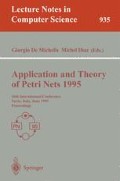Abstract
Markov Regenerative Stochastic Petri Nets (MRSPN) have been recently introduced in the literature with the aim of combining exponential and non-exponential firing times into a single model. However, the realizations of the general MRSPN model, so far discussed, require that at most a single non-exponential transition is enabled in each marking and that its associated memory policy is of enabling type. The present paper extends the previous models by allowing the memory policy to be of age type and by allowing multiple general transitions to be simultaneously enabled, provided that their enabling intervals do not overlap. A final completely developed example, that couldn't have been considered in previous formulations, derives the closed form expressions for the transient state probabilities for a queueing system with preemptive resume (prs) service policy.
Preview
Unable to display preview. Download preview PDF.
References
M. Ajmone Marsan, G. Balbo, A. Bobbio, G. Chiola, G. Conte, and A. Cumani. The effect of execution policies on the semantics and analysis of stochastic Petri nets. IEEE Transactions on Software Engineering, SE-15:832–846, 1989.
M. Ajmone Marsan and G. Chiola. On Petri nets with deterministic and exponentially distributed firing times. In Lecture Notes in Computer Science, volume 266, pages 132–145. Springer Verlag, 1987.
A. Bobbio. Stochastic reward models in performance/reliability analysis. Journal on Communications, XLIII:27–35, January 1992.
A. Bobbio and M. Telek. Task completion time. In Proceedings 2nd International Workshop on Performability Modelling of Computer and Communication Systems (PMCCS2), 1993.
A. Bobbio and M. Telek. Computational restrictions for SPN with generally distributed transition times. In D. Hammer K. Echtle and D. Powell, editors, First European Dependable Computing Conference (EDCC-1), Lecture Notes in Computer Science, volume 852, pages 131–148, 1994.
A. Bobbio and M. Telek. Markov regenerative SPN with non-overlapping activity cycles. In International Computer Performance and Dependability Symposium — IPDS95, April 1995.
Hoon Choi, V.G. Kulkarni, and K. Trivedi. Transient analysis of deterministic and stochastic Petri nets. In Proceedings of the 14-th International Conference on Application and Theory of Petri Nets, Chicago, June 1993.
Hoon Choi, V.G. Kulkarni, and K. Trivedi. Markov regenerative stochastic Petri nets. Performance Evaluation, 20:337–357, 1994.
G. Ciardo, R. German, and C. Lindemann. A characterization of the stochastic process underlying a stochastic Petri net. IEEE Transactions on Software Engineering, 20:506–515, 1994.
G. Ciardo and C. Lindemann. Analysis of deterministic and stochastic Petri nets. In Proceedings International Workshop on Petri Nets and Performance Models — PNPM93, pages 160–169. IEEE Computer Society, 1993.
E. Cinlar. Introduction to Stochastic Processes. Prentice-Hall, Englewood Cliffs, 1975.
A. Cumani. Esp — A package for the evaluation of stochastic Petri nets with phase-type distributed transition times. In Proceedings International Workshop Timed Petri Nets, pages 144–151, Torino (Italy), 1985. IEEE Computer Society Press no. 674.
R. German and C. Lindemann. Analysis of stochastic Petri nets by the method of supplementary variables. Performance Evaluation, 20:317–335, 1994.
D.L. Jagerman. An inversion technique for the Laplace transform. The Bell System Technical Journal, 61:1995–2002, October 1982.
V.G. Kulkarni, V.F. Nicola, and K. Trivedi. On modeling the performance and reliability of multi-mode computer systems. The Journal of Systems and Software, 6:175–183, 1986.
C. Lindemann. An improved numerical algorithm for calculating steady-state solutions of deterministic and stochastic Petri net models. Performance Evaluation, 18:75–95, 1993.
A. Reibman, R. Smith, and K.S. Trivedi. Markov and Markov reward model transient analysis: an overview of numerical approaches. European Journal of Operational Research, 40:257–267, 1989.
Author information
Authors and Affiliations
Editor information
Rights and permissions
Copyright information
© 1995 Springer-Verlag Berlin Heidelberg
About this paper
Cite this paper
Telek, M., Bobbio, A. (1995). Markov Regenerative Stochastic Petri Nets with age type general transitions. In: De Michelis, G., Diaz, M. (eds) Application and Theory of Petri Nets 1995. ICATPN 1995. Lecture Notes in Computer Science, vol 935. Springer, Berlin, Heidelberg. https://doi.org/10.1007/3-540-60029-9_55
Download citation
DOI: https://doi.org/10.1007/3-540-60029-9_55
Published:
Publisher Name: Springer, Berlin, Heidelberg
Print ISBN: 978-3-540-60029-9
Online ISBN: 978-3-540-49408-9
eBook Packages: Springer Book Archive

